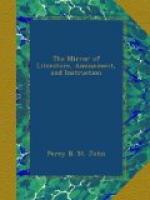The Belvoir estate came into the Manners family, by the marriage of Eleanor with Robert de Manners of Ethale, Northumberland. Eleanor was the eldest sister of Edmund, Lord Ros, who resided at the manor-house of Elsinges, in Enfield, Middlesex, where he died without issue in the year 1508. His sisters became heiresses to the estates, and Belvoir being part of the moiety of Eleanor, became the property of the Manners family, who have continued to possess it to the present time.
As the possessors of this castle and lordship have been chiefly persons of considerable eminence, and many of them numbered among the great men of history, it may be as well to interweave a few notices of them with a brief chronological account of the noble structure. Robert, the first Norman lord, died in 1088, and was buried in the chapter-house of the Priory, where Dr. Stukely discovered the stone already named, to his memory. “By a general survey taken at the death of Robert, it appears that he was in possession of fourscore lordships: many of which, by uninterrupted succession, continue still to be the property of the Duke of Rutland. In Lincolnshire his domains were still more numerous. In Northamptonshire he had nine lordships; one of which, Stoke, acquired the additional name of Albini, when it came into the possession of his son.” William de Albini, son of the above, succeeded to these lordships; and, like his father, was a celebrated warrior: according to Matthew Paris, he valourously distinguished himself at the battle of Tinchebrai, in Normandy, September 27, 1106; where Henry I. encountered Robert Curthose, his brother. This lord obtained from Henry the grant of an annual fair at Belvoir, to be continued for eight days. During the changeful reigns of Stephen and Henry II., the castle fell into the hands of the crown, and was granted to Ranulph de Gernons, Earl of Chester; but repossession was obtained by de Albini, who died here about the year 1155. William de Albini, (alias Meschines and Britto,) the next possessor of Belvoir, endowed the Priory hero with certain lands, and, in 1165, certified to Henry II. that he then held of him thirty-two knights’ fees under the old feoffments, whereby he was enfeoffed in the time of Henry I. William de Albini, the third of that name, accompanied Richard I. during his crusading reign, into Normandy: he was also one of the sureties for King John, in his treaty of peace with Philip of France. He was too, engaged in the barons’




